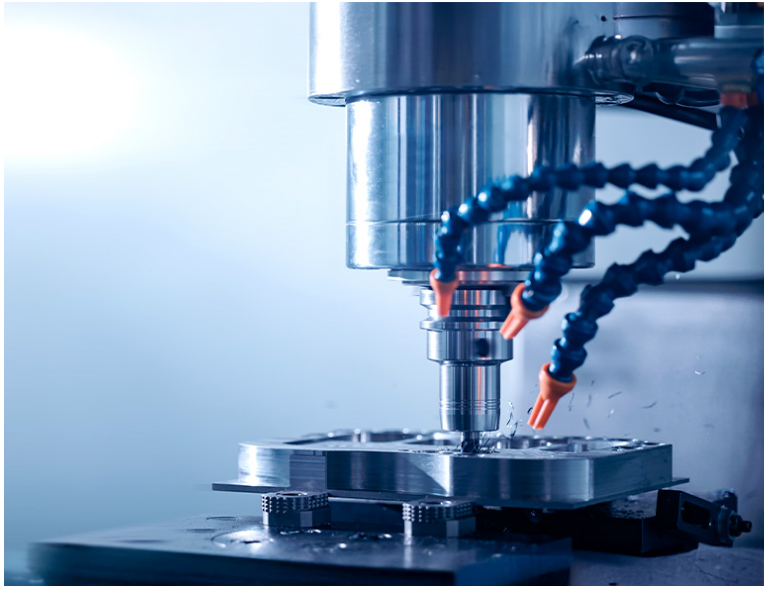
19/03/2025
The CNC lathe is one of the most widely used machine tools in industry for precision machining of metal, plastic, and other materials. But what exactly is a CNC lathe, how does it work and in what application is it used?
In this article we will explore how this machine works, its historical origins, and the main machining operations it can perform, to understand its importance in the modern manufacturing contest.
The first real turning point came in 1940s with the introduction of numerical control (NC), which used punched cards to manage machine movements. However, we will have to wait until the 1970s for the development of the CNC (Computer Numerical Control) lathe. Here, control is completely entrusted to a computer system that transforms the part drawing into commands understandable by the machine.
The introduction of CNC has radically changed the world of precision engineering, enabling faster, more precise, and automated machining. With programming using CAD/CAM software, the CNC lathe can produce components with minimal tolerance and perform complex operations with great efficiency.
The operation of CNC lathes is based on CAD/CAM software, which generates the machining program from the component drawing. The program contains all necessary instructions, such as rotation speed, depth of cut, feed rate, and tool movements along the X and Z axes. This information allows lathes to work autonomously with pinpoint accuracy, consistency repeatability, minimizing error, and optimizing production time.
With advanced programming and millimeter accuracy, it enables highly sophisticated results to be achieved in a short time.
The main machining operations that can be performed with a CNC lathe include:
Every machining operation performed with the CNC lathe relies on the precision and reliability of numerical control, which allows parts to be reproduced with minimal tolerances and automates the process to reduce human error. This level of precision and automation is what makes the CNC lathe an indispensable machine in many industries.
The CNC lathe is a key tool for achieving precision and versatility in a wide range of machining operations, from aerospace to automotive. With its advanced capabilities, it offers ideal solutions for high-precision manufacturing.
Guerrini Lauro is a reliable partner for precision machining, with CNC lathes capable of meeting customers' specific needs. If you would like to find out how we can optimize your production processes, contact us for a consultation.
CNC lathe: what is it and what machining operations is it used for?
The CNC lathe is one of the most widely used machine tools in industry for precision machining of metal, plastic, and other materials. But what exactly is a CNC lathe, how does it work and in what application is it used?
In this article we will explore how this machine works, its historical origins, and the main machining operations it can perform, to understand its importance in the modern manufacturing contest.
- The origin of the CNC lathe
- What is a CNC lathe and how does it work?
- The main machining operations that can be performed with the CNC lathe
- What materials can be machined with a CNC lathe?
- Applications of the CNC lathe in industrial sectors
The origin of the CNC lathe
The history of lathe has its roots in antiquity: the earliest forms were rudimentary and were operated manually, mainly for woodworking. As technology evolved, the lathe began to be driven by steam engines and later by electricity.The first real turning point came in 1940s with the introduction of numerical control (NC), which used punched cards to manage machine movements. However, we will have to wait until the 1970s for the development of the CNC (Computer Numerical Control) lathe. Here, control is completely entrusted to a computer system that transforms the part drawing into commands understandable by the machine.
The introduction of CNC has radically changed the world of precision engineering, enabling faster, more precise, and automated machining. With programming using CAD/CAM software, the CNC lathe can produce components with minimal tolerance and perform complex operations with great efficiency.
What is a CNC lathe and how does it work?
CNC lathes is a machine tool that, through a numerical control system, performs high-precision machining operations. The machine can perform operations such as turning, milling, and drilling, Thanks to software that allows the tool and workpiece movements to be programmed.The operation of CNC lathes is based on CAD/CAM software, which generates the machining program from the component drawing. The program contains all necessary instructions, such as rotation speed, depth of cut, feed rate, and tool movements along the X and Z axes. This information allows lathes to work autonomously with pinpoint accuracy, consistency repeatability, minimizing error, and optimizing production time.
Types of CNC lathe and use of axes
CNC lathes also differ in the number of axes they can handle:- 2 axes (X and Z): basic machining such as external and internal turning.
- 3 axes (X, Y, and Z): more precise and articulated machining, such as milling and drilling on more complex surface.
- 4 axes: multidimensional workpiece movement, suitable for machining at different angles and more complex geometries.
- 5 axes: greater freedom of movement for advanced machining, ideal for components with special shapes or nonlinear geometries.
- 7 axes: used for high-precision applications requiring complex movements and particularly articulated machining on parts with extremely precise geometries.
The main machining operations that can be performed with the CNC lathe
The CNC lathe is extremely versatile and capable of performing a wide range of machining operations, ranging from simple turning of cylindrical shapes to much more complex processes.With advanced programming and millimeter accuracy, it enables highly sophisticated results to be achieved in a short time.
The main machining operations that can be performed with a CNC lathe include:
- External and internal turning
The external turning is the machining of a cylindrical external surface, in which the tool is run along the surface of the rotating workpiece. This produces parts with perfect cylindrical shapes, such as shafts, cranks, and crankshafts. Internal turning, on the other hand, is used to create precise cylindrical holes and cavities within a component. - CNC Threading
CNC lathes can be used to make high-precision threads on metal, plastic or other alloy components. This machining makes it possible to create screws and bolts, as well as more complex threads such as trapezoidal and Whitworth threads. The main advantage is the creation of parts with very tight tolerances which are essential in industries such as aerospace and automotive. - Milling and drilling
Some advanced CNC lathes also have built.in milling machines that enable operation such as machining complex shapes, cavities, grooves and special profiles. Drilling is another important process that the CNC lathe performs, making holes with precise diameters and depths. - Shaping complex profiles
Because of its ability to perform multiple movements along axes, the CNC lathe can be used to shape complex profiles out of a variety of materials. With CAD/CAM software, the lathe can be programmed to work on surfaces with special angles, curves or nonlinear geometries. This is especially useful in making components with irregular shapes or complex geometric details, such as those used in the aerospace industry and medical equipment manufacturing. - Fine finish surface machining
These operations are essential to obtain smooth, flawless surfaces suitable for components that require a high level of aesthetic or functional precision. With CNC lathes, higher quality surfaces can be obtained, even reducing the need for post-machining operations. - Machining of composite materials
CNC lathes can also composite materials such as carbon fibers, reinforced plastics, and hybrid materials. These require specialized equipment and can be machined with a CNC lathe to create lightweight but strong parts used in industries such as automotive, aerospace, and the sports industry.
Every machining operation performed with the CNC lathe relies on the precision and reliability of numerical control, which allows parts to be reproduced with minimal tolerances and automates the process to reduce human error. This level of precision and automation is what makes the CNC lathe an indispensable machine in many industries.
What materials can be machined with a CNC lathe?
The CNC lathe can machine a wide range of materials, adapting to the needs of various industries. Materials that can be machined with the CNC lathe include:- Ferrous metals such as steel and cast iron
- Nonferrous metals such as aluminum, copper and brass
- High-strength plastics, such as engineering polymers
- Special alloys, such as titanium, mainly used in the aerospace industry
Applications of the CNC lathe in industrial sectors
The CNC lathe is used in various industries because of its precision and ability to make complex components. Some of the main ones include:- Aerospace industry: for making high-precision components, such as engine parts and structures.
- Automotive industry: for making gears, crankshafts and other mechanical parts.
- Medical industry: for making prosthetics, surgical instruments and other medical devices.
- Electronics industry: for manufacturing connectors and components for electronic circuits.
The CNC lathe is a key tool for achieving precision and versatility in a wide range of machining operations, from aerospace to automotive. With its advanced capabilities, it offers ideal solutions for high-precision manufacturing.
Guerrini Lauro is a reliable partner for precision machining, with CNC lathes capable of meeting customers' specific needs. If you would like to find out how we can optimize your production processes, contact us for a consultation.

 Design by
Design by